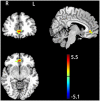Increased Low-Frequency Resting-State Brain Activity by High-Frequency Repetitive TMS on the Left Dorsolateral Prefrontal Cortex
- PMID: 29312097
- PMCID: PMC5744634
- DOI: 10.3389/fpsyg.2017.02266
Increased Low-Frequency Resting-State Brain Activity by High-Frequency Repetitive TMS on the Left Dorsolateral Prefrontal Cortex
Abstract
Beneficial effects of repetitive transcranial magnetic stimulation (rTMS) on left dorsolateral prefrontal cortex (DLPFC) have been consistently shown for treating various neuropsychiatrical or neuropsychological disorders, but relatively little is known about its neural mechanisms. Here we conducted a randomized, double-blind, SHAM-controlled study to assess the effects of high-frequency left DLPFC rTMS on resting-state activity. Thirty-eight young healthy subjects received two sessions of either real rTMS (N = 18, 90% motor-threshold; left DLPFC at 20 Hz) or SHAM TMS (N = 20) and functional magnetic resonance imaging scan during rest in 2 days separated by 48 h. Resting-state bran activity was measured with the fractional amplitude of low-frequency fluctuation (fALFF) and functional connectivity (FC). Increased fALFF was found in rostral anterior cingulate cortex (rACC) after 20 Hz rTMS, while no changes were observed after SHAM stimulation. Using the suprathreshold rACC cluster as the seed, increased FC was found in left temporal cortex (stimulation vs. group interaction). These data suggest that high-frequency rTMS on left DLPFC enhances low-frequency resting-state brain activity in the target site and remote sites as reflected by fALFF and FC.
Keywords: anterior cingulate cortex; default mode network; dorsolateral prefrontal cortex; functional magnetic resonance imaging; transcranial magnetic stimulation (TMS).
Figures



Similar articles
-
Repetitive transcranial magnetic stimulation (rTMS) of the dorsolateral prefrontal cortex reduces resting-state insula activity and modulates functional connectivity of the orbitofrontal cortex in cigarette smokers.Drug Alcohol Depend. 2017 May 1;174:98-105. doi: 10.1016/j.drugalcdep.2017.02.002. Epub 2017 Feb 28. Drug Alcohol Depend. 2017. PMID: 28319755 Free PMC article. Clinical Trial.
-
Neural correlates of approach-avoidance behavior in healthy subjects: Effects of low-frequency repetitive transcranial magnetic stimulation (rTMS) over the right dorsolateral prefrontal cortex.Int J Psychophysiol. 2024 Sep;203:112392. doi: 10.1016/j.ijpsycho.2024.112392. Epub 2024 Jul 11. Int J Psychophysiol. 2024. PMID: 39002638
-
Effects of repetitive transcranial magnetic stimulation combined with cognitive training on resting-state brain activity in Alzheimer's disease.Neuroradiol J. 2022 Oct;35(5):566-572. doi: 10.1177/19714009211067409. Epub 2022 Jan 12. Neuroradiol J. 2022. PMID: 35019804 Free PMC article.
-
Implications of Transcranial Magnetic Stimulation as a Treatment Modality for Tinnitus.J Clin Med. 2021 Nov 20;10(22):5422. doi: 10.3390/jcm10225422. J Clin Med. 2021. PMID: 34830704 Free PMC article. Review.
-
Transcranial Magnetic Stimulation for Post-traumatic Stress Disorder.Front Psychiatry. 2022 May 31;13:701348. doi: 10.3389/fpsyt.2022.701348. eCollection 2022. Front Psychiatry. 2022. PMID: 35711594 Free PMC article. Review.
Cited by
-
Insight Into the Effects of Clinical Repetitive Transcranial Magnetic Stimulation on the Brain From Positron Emission Tomography and Magnetic Resonance Imaging Studies: A Narrative Review.Front Neurosci. 2022 Feb 21;16:787403. doi: 10.3389/fnins.2022.787403. eCollection 2022. Front Neurosci. 2022. PMID: 35264923 Free PMC article. Review.
-
Resting-State fMRI Functional Connectivity Strength Predicts Local Activity Change in the Dorsal Cingulate Cortex: A Multi-Target Focused rTMS Study.Cereb Cortex. 2022 Jun 16;32(13):2773-2784. doi: 10.1093/cercor/bhab380. Cereb Cortex. 2022. PMID: 34689201 Free PMC article.
-
Effects of repetitive transcranial magnetic stimulation and their underlying neural mechanisms evaluated with magnetic resonance imaging-based brain connectivity network analyses.Eur J Radiol Open. 2023 Jun 8;10:100495. doi: 10.1016/j.ejro.2023.100495. eCollection 2023. Eur J Radiol Open. 2023. PMID: 37396489 Free PMC article. Review.
-
Effects of repetitive transcranial magnetic stimulation in children and young people with psychiatric disorders: a systematic review.Eur Child Adolesc Psychiatry. 2025 Feb;34(2):403-422. doi: 10.1007/s00787-024-02475-x. Epub 2024 May 29. Eur Child Adolesc Psychiatry. 2025. PMID: 38809301 Free PMC article.
-
Repetitive Transcranial Magnetic Stimulation Target Location Methods for Depression.Front Neurosci. 2021 Sep 9;15:695423. doi: 10.3389/fnins.2021.695423. eCollection 2021. Front Neurosci. 2021. PMID: 34566561 Free PMC article. Review.
References
LinkOut - more resources
Full Text Sources
Other Literature Sources

